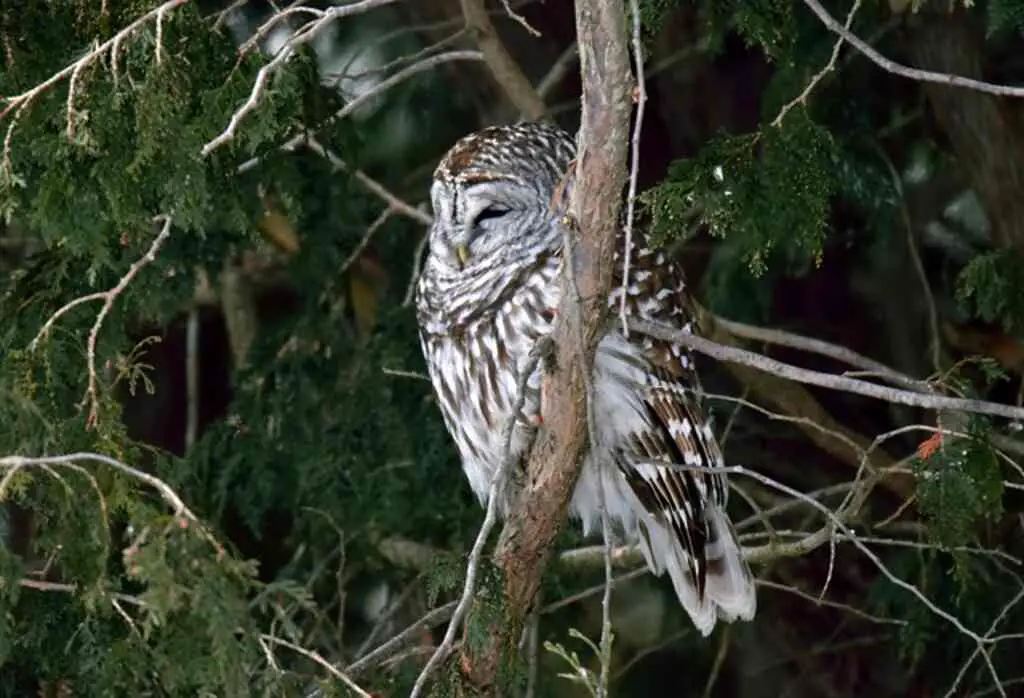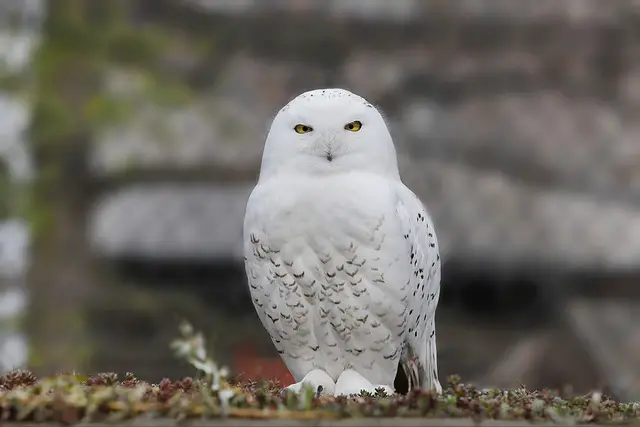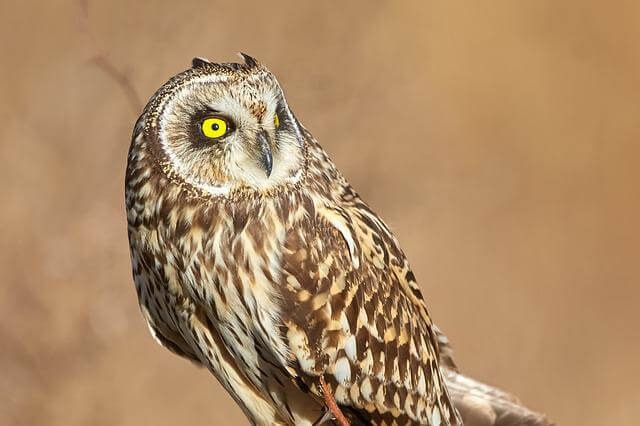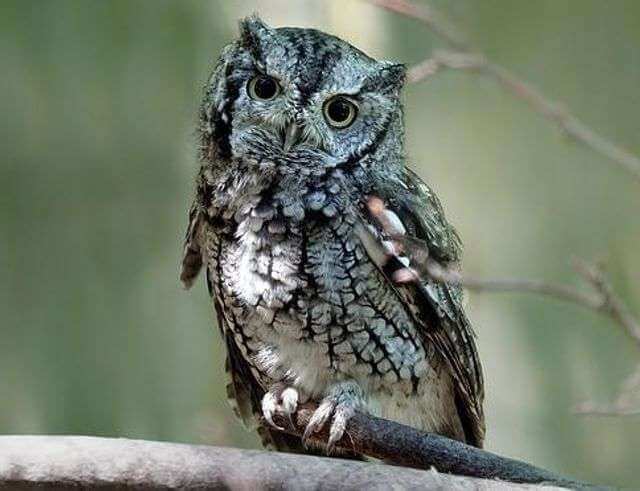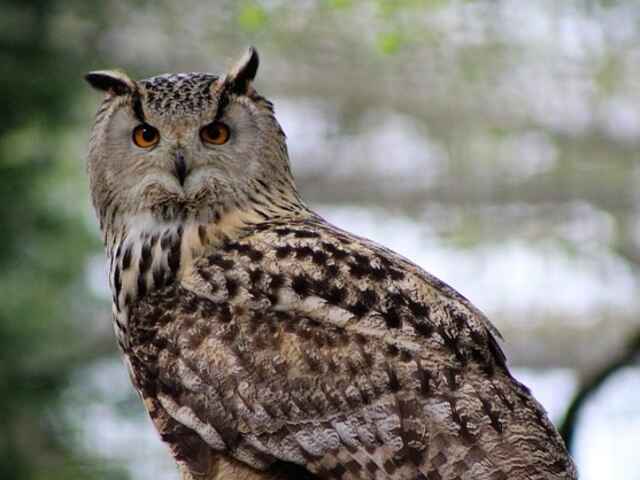Welcome to the definitive guide to all types of owls in Maine for 2023! With Maine’s diverse landscape, it should come as no surprise that it is also home to a variety of owl species and subspecies. In this blog post, we will explore twelve types of owls you can find in Maine, so you can get acquainted with the birds that call it home.
We include detailed descriptions of identification tips, natural habitats, and more to equip you with all the information you need to successfully identify different owl species in the state. So, let’s start our journey into the wonderful world of Maine Owls!
Table of Contents
Types of Owls in Maine
Barred Owl
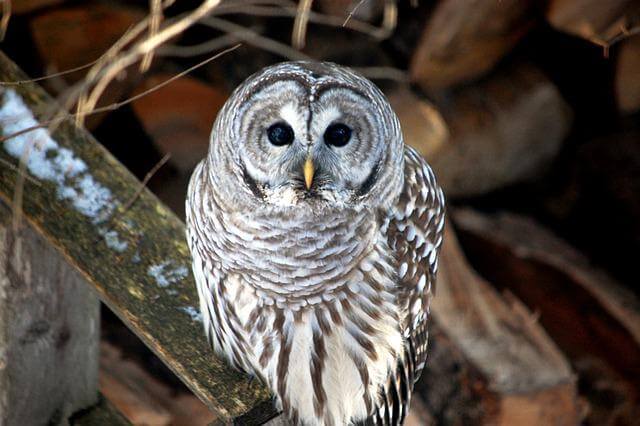
- Length: 16.9-19.7 in (43-50 cm)
- Weight: 16.6-37.0 oz (470-1050 g)
- Wingspan: 39.0-43.3 in (99-110 cm)
- Scientific Name: Strix varia
- Frequency of Occurrence: 1.33% (Statistic by: eBird)
- Maps: Range Map – Sightings Map
- Sounds: Calls and Songs
- Where To Find Them: The first place to visit is Moosehorn National Wildlife Refuge in Washington County. This refuge has forests, meadows, wetlands, and marshes—the perfect habitat for the barred owl. You can also find them at Aroostook State Park in Presque Isle or Gilsland Farm Audubon Center in Falmouth; both areas have plenty of trees that provide shelter and food sources like small mammals or insects that the owls love to eat!
- How to Attract: Start by providing the perfect habitat for this bird species. Plant trees that will provide dense foliage, and select trees with wide branches which provide sheltered roosting spots. Additionally, adding small bird houses or nesting boxes may encourage them to take up residence in your yard. It’s also important to leave leaves, logs and other natural debris throughout the property as this will attract other prey species such as small rodents which are an essential part of their diet. In addition to creating an inviting environment, it’s important not to disturb their habitat too often or too close by when they begin visiting the area.
General Information: The Barred Owl (Strix varia) is a fairly large owl living in the North America continental area. Its range extends across the continent, including Canada, Alaska, and Mexico. The Barred Owl prefers wooded habitats, particularly those with water nearby.
It is an opportunistic hunter and its diet consists of small mammals, amphibians, reptiles, fish, insects and other birds. Depending on local availability, it may also feed on fruits and berries. The Barred Owl can be found in a variety of habitats including deciduous forests, mixed coniferous-deciduous forests, swamps, riparian areas and urban parks.
Snowy Owl
- Length: 20.5-27.9 in (52-71 cm)
- Weight: 56.4-104.1 oz (1600-2950 g)
- Wingspan: 49.6-57.1 in (126-145 cm)
- Scientific Name: Bubo scandiacus
- Frequency of Occurrence: 0.3574%
- Maps: Range Map – Sightings Map
- Sounds: Calls and Songs
- Where To Find Them: The best chance to see a Snowy owl is during winter months, when they migrate to Maine from their Arctic breeding grounds. For those looking to catch a glimpse of this fascinating creature, the best spots can be found along coastal areas such as Portland Headlight in Cape Elizabeth. Coastal areas tend to be the gathering places for Snowy owls, since small rodents like voles are commonly found there. If friends want to join you on your snowy owl search, consider heading to Scarborough Marsh or Wells National Estuarine Research Reserve, where multiple sightings have been reported.
- How to Attract: The first step is creating an inviting habitat for the Snowy Owl. They tend to prefer open areas with plenty of perch spots such as power lines or fence posts where they can keep an eye out for their prey. Adding nest boxes or birdhouses near trees or shrubs can also help attract them to your yard. Secondly, providing food such as mealworms is crucial in order to keep them coming back once they’ve realized this is a safe place for them!
General Information: The Snowy Owl (Bubo scandiacus) is a large white owl native to Arctic regions in North America and Eurasia. It is reported in open tundra habitats, like prairies, meadows, marshes and fields. The snowy owl is a carnivore, and subsists mainly on voles, hares, and lemmings. They also eat birds like ptarmigan, ducks and shorebirds. In the summer months, they may also feed on insects like beetles and moths.
Snowy owls are migratory birds and will move south during winter when food sources become scarce in their northern range. During these migrations, they may be seen as far south as the southern United States or even Mexico. However, some individuals remain in their northern range year-round if there is an abundance of food available.
Read More: 48 Fun Facts About Snowy Owls (Full Guide with Photos!)
Great Horned Owl

- Length: 18.1-24.8 in (46-63 cm)
- Weight: 32.1-88.2 oz (910-2500 g)
- Wingspan: 39.8-57.1 in (101-145 cm)
- Scientific Name: Bubo virginianus
- Frequency of Occurrence: 0.3533%
- Maps: Range Map – Sightings Map
- Sounds: Calls and Songs
- Where To Find Them: From coastal forests and marshes, to woodlands and meadows, these predators can be seen roosting high up in trees. Rachel Carson National Wildlife Refuge near Wells Beach is an excellent spot for viewing these owls over the summer months when their young have left the nest. Audubon’s Scarborough Marsh Reserve is also worth visiting if you want a chance at seeing one soar gracefully through the air on its hunt for prey.
- How to Attract: The first step is creating a habitat that’s suitable for owls. Make sure there are plenty of trees and shrubs with thick foliage that provide shelter for them. You can also install nest boxes or roosts, which will make it easier for the owl to find a spot where they can easily build their nests and rest. Additionally, leaving any old logs or dead trees in your yard helps create an inviting home for owls since they naturally like quiet corners and dense coverings.
General Information: The Great Horned Owl is a mysterious creature of the night. With its distinctive hoot, these owls can be found from Canada to the southern tip of South America. This majestic bird thrives in diverse habitats, adapting to grasslands, forests, deserts and even urban areas. This stealthy hunter has huge eyes that are able to spot prey up to 50 feet away. They have an impressive diet that includes rabbits and hares, reptiles, amphibians and even skunks!
Great Horned Owls will also enjoy a meal of small rodents like mice or voles. Nocturnal by nature, these birds of prey are rarely seen during the day as they sleep in dense foliage high up in trees. Keep your eyes peeled for this magnificent hunter on your next outdoor adventure!
Read More: 35 Fun Facts About The Great Horned Owl (Detailed)
Northern Saw-whet Owl

- Length: 7.1-8.3 in (18-21 cm)
- Weight: 2.3-5.3 oz (65-151 g)
- Wingspan: 16.5-18.9 in (42-48 cm)
- Scientific Name: Aegolius acadicus
- Frequency of Occurrence: 0.1575%
- Maps: Range Map – Sightings Map
- Sounds: Calls and Songs
- Where To Find Them: In Maine, there are several places where one can spot the Northern Saw-whet Owl. A great location to view them is Acadia National Park, which offers numerous trails and boardwalks for birdwatchers and nature lovers. The park also provides the perfect habitat for this species with plenty of old growth trees and shrubs providing nesting sites as well as ample food sources such as voles, mice, and insects.
- How to Attract: First, create a natural environment where the Northern Saw-whet Owl will feel welcome. Make sure there are plenty of trees and shrubs for them to perch on and hunt from. Planting native plants that produce berries or fruits is also a great way to provide food for these birds. You may also want to consider putting up nesting boxes in your backyard so they have somewhere safe and comfortable to raise their families. Finally, provide water sources such as ponds or birdbaths.
General Information: The Northern Saw-whet Owl is a small and surprisingly vocal member of the owl family. These owls are native to North America, and occupy habitats from southern Canada all the way to Mexico. They prefer dense forests of pine, spruce, aspen, fir, and cedar trees with heavy ground cover for nesting. The diet of a Northern Saw-whet Owl consists mainly of voles, mice and other small rodents that they catch near or on the ground.
They will also take an occasional bird or two during the winter months when food is scarce. To find their prey they use their acute hearing and eyesight to listen for rustling in the undergrowth at night. In addition to living in woodlands, these small owls can adapt well to suburban areas too! People often see them perching quietly on fences or in trees around yards – just keep your eyes peeled!
Read More: What is the Smallest Owl in North America? (A Full Guide)
Short-eared Owl
- Length: 13.4-16.9 in (34-43 cm)
- Weight: 7.3-16.8 oz (206-475 g)
- Wingspan: 33.5-40.5 in (85-103 cm)
- Scientific Name: Asio flammeus
- Frequency of Occurrence: 0.0547%
- Maps: Range Map – Sightings Map
- Sounds: Calls and Songs
- Where To Find Them: For starters, try Acadia National Park. This stunning park is home to many species of birds and animals – including Short-eared Owls! Every spring and fall, visitors flock here for the chance to catch a glimpse of these magnificent creatures soaring through the night sky. A visit during dusk or dawn will give you the best chance at spotting one! Another great place for owl watching is Quoddy Head State Park.
- How to Attract: First, make sure the area around your property has plenty of open space for owls to hunt. These owls love grasslands and meadows with short vegetation, where they can spot small prey such as voles or mice. Additionally, try leaving out food sources such as insects or field mice every day – this will help draw in the hungry birds. You can also set up roosting sites like tree cavities or nest boxes; these sites provide shelter from predators and offer a safe place for nesting during breeding season.
General Information: The mysterious and intriguing Short-eared Owl is a captivating sight to behold. With its distinct heart-shaped face and mottled brown plumage, it is a raptor of the night skies – but not all that is known about this special bird. Short-eared Owls are found worldwide in open habitats such as grasslands, meadows, marshes and tundra. They migrate south in winter months to hunt for food in more temperate environments like agricultural lands or wetlands.
Their diet consists mainly of small mammals such as voles, mice and shrews, which they silently swoop down upon from above. This unique owl’s presence is always an exciting one; it provides an opportunity to observe a rare creature in its natural environment, where it has lived for millennia. Its silent flight and mysterious habits make it the perfect bird for any wildlife enthusiast!
Northern Hawk Owl
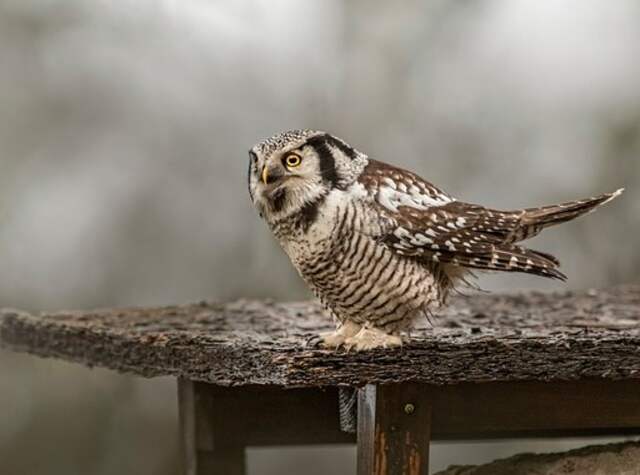
- Length: 14.2-17.7 in (36-45 cm)
- Weight: 8.5-16.0 oz (240-454 g)
- Wingspan: 27.9 in (71 cm)
- Scientific Name: Surnia ulula
- Frequency of Occurrence: 0.0207%
- Maps: Range Map – Sightings Map
- Sounds: Calls and Songs
- Where To Find Them: The best time to spot the Northern Hawk Owl in Maine is between April and June, when they migrate northward after nesting season in Canada. They tend to prefer forested areas with scattered trees and open spaces – making Acadia National Park an ideal location for spotting the owl during their migration season. Keep an eye out while walking through forests near lakes or streams, where these owls often hunt for prey like voles and mice.
- How to Attract: To get started, the first step is to provide the necessary food sources that they need. You can also offer suet, mealworms, birdseed mixes and even live crickets for supplemental meals. The next step is to create a safe place for the owls to nest and roost. Ideally, trees with dense foliage should be planted near your feeders as it will provide essential protection from predators. If possible, try to create more than one perching site so that there are multiple areas of protection available when needed.
General Information: The Northern Hawk Owl is a delightful little creature of the owl family, native to the northern regions of North America and Eurasia. Its range stretches from Alaska in the west, across Canada and Northern Europe to Siberia in the east. This majestic bird has captivated birdwatchers with its unique look and behavior for centuries. Its habitat ranges from dense boreal forests to open tundra, where it can be seen perched atop trees or posts for hours at a time scanning for prey with its bright yellow eyes.
The Northern Hawk Owl feeds mainly on small mammals like voles, mice, shrews and squirrels, but also enjoys supplementary meals of insects, birds and even reptiles. With its exceptional vision and agility, it can swoop down upon unsuspecting prey with amazing speed – a truly remarkable sight!
Great Gray Owl
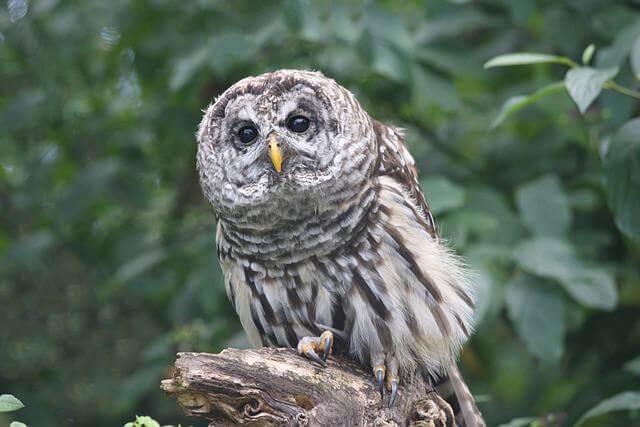
- Length: 24.0-33.1 in (61-84 cm)
- Weight: 24.7-60.0 oz (700-1700 g)
- Wingspan: 53.9-60.2 in (137-153 cm)
- Scientific Name: Strix nebulosa
- Frequency of Occurrence: 0.0148%
- Maps: Range Map – Sightings Map
- Sounds: Calls and Songs
- Where To Find Them: The first place to look for Great Gray Owls is Baxter State Park. This park is teeming with wildlife, and it’s the perfect location to see the owls nesting or soaring through the sky. The Aroostook National Wildlife Refuge located in Limestone also provides optimal conditions for spotting these striking creatures, as they often perch atop trees near lakes and ponds during hunting season. Additionally, Moosehorn National Wildlife Refuge in Baring offers miles of hiking trails through woodlands and wetlands where Great Gray Owls can be seen flying around looking for food or perched on branches watching over their territory.
- How to Attract: Start by making sure your yard offers an optimal habitat for the Great Gray Owl. These birds prefer open forests with plenty of space for hunting small mammals like mice and voles. Additionally, it would be beneficial to install nesting boxes or platforms in areas near food sources, as this gives them a safe place to rest and breed. Planting native shrubs, trees and wildflowers can also provide perches and shelter while creating a natural food source through insects.
General Information: The Great Gray Owl, one of the largest owl species, is a powerful yet majestic bird found all across the Northern Hemisphere. Its impressive size and unique features have made it an iconic symbol of strength and beauty. From its massive wingspan to its striking yellow eyes, this predator captivates observers with its grandeur. The Great Gray Owl’s range spans from Northern Europe to North America and Asia.
It prefers dense coniferous forests or taiga ecosystems, as they provide ample cover for hunting, while also offering plentiful food sources in the form of rodents and small mammals. This species is highly adaptable, though; when faced with changing weather conditions or deforestation, they may be found venturing into fields or even suburban areas in search of sustenance.
Read More: 53 Fun Facts About The Great Gray Owl (Photos, ID & Info)
Eastern Screech Owl
- Length: 6.3-9.8 in (16-25 cm)
- Weight: 4.3-8.6 oz (121-244 g)
- Wingspan: 18.9-24.0 in (48-61 cm)
- Scientific Name: Megascops asio
- Frequency of Occurrence: 0.0088%
- Maps: Range Map – Sightings Map
- Sounds: Calls and Songs
- Where To Find Them: The best place to find an Eastern Screech Owl in Maine is Acadia National Park. Here, visitors can take a hike on one of the many trails where you’re likely to see these birds perched among pine trees or soaring across open skies. In addition, nearby forests such as Mount Desert Island and Penobscot Bay offer excellent opportunities for spotting these owls as well – particularly during early morning hours when they are more active!
- How to Attract: To start, create an inviting environment for the owls. Plant trees or shrubs that provide food, such as berries and nuts, as well as cover and nesting sites. Place birdhouses near where they already feed or roost, preferably near a nearby water source like a pond or stream. You can also add special owl boxes designed specifically with features that Eastern Screech Owls prefer.
General Information: The Eastern Screech Owl is found mainly in the eastern and central parts of North America. These small owls have adapted to a variety of habitats, from forests and woodlands, to open plains and cities. They are often seen perched atop branches or fence posts during the day, or heard calling at night.
Diet-wise, they feed primarily on small rodents and insects, but can also snatch up small birds like sparrows. The Eastern Screech Owl plays an important role in balancing the local food chain by predating certain rodent species that could otherwise become pests. These agile hunters are undeniably fascinating creatures with their distinctive appearance and impressive predator skills!
Long-eared Owl
- Length: 13.8-15.8 in (35-40 cm)
- Weight: 7.8-15.3 oz (220-435 g)
- Wingspan: 35.4-39.4 in (90-100 cm)
- Scientific Name: Asio otus
- Frequency of Occurrence: 0.0029%
- Maps: Range Map – Sightings Map
- Sounds: Calls and Songs
- Where To Find Them: Maine is a great place to spot the majestic Long-eared Owl! These mysterious birds of prey are a thrill to observe in their natural environment. The best spots for spotting Long-eared Owls in Maine are along rivers, lakes and woodland areas. In particular, these birds can be found in the suburbs of Bangor and Orono, and near Sebago Lake State Park.
- How to Attract: The first step is to provide a safe habitat where the owls will feel secure. This could include large trees with thick foliage and plenty of natural hiding spots for them, such as hollowed logs or dense shrubs. You should also create an accessible food source by placing bird feeders around your yard with mealworms; this will encourage owls to visit regularly. Additionally, place water sources near your feeders so that the owls have easy access to refreshment during their visits. Finally, make sure that there is minimal human activity in the area; avoid loud noises and bright lights at night, which could disturb any potential visitors.
General Information: The Long-eared Owl is a unique species of owl, easily recognizable by its long ear tufts that give it its name. This nocturnal bird can be found in both temperate and boreal forests throughout North America, Europe, Asia, and even northern Africa. With a range that spans from pole to pole, the Long-eared Owl is an impressive traveler!
When looking for a suitable habitat for roosting and hunting at night, these owls prefer dense forest edges or thickets near open clearings. In addition to their wide range of habitats across the globe, Long-eared Owls also have an extremely varied diet — they’ll feast on small mammals such as voles and mice but will also take advantage of insects like beetles and moths. They may even catch birds on occasion!
Burrowing Owl
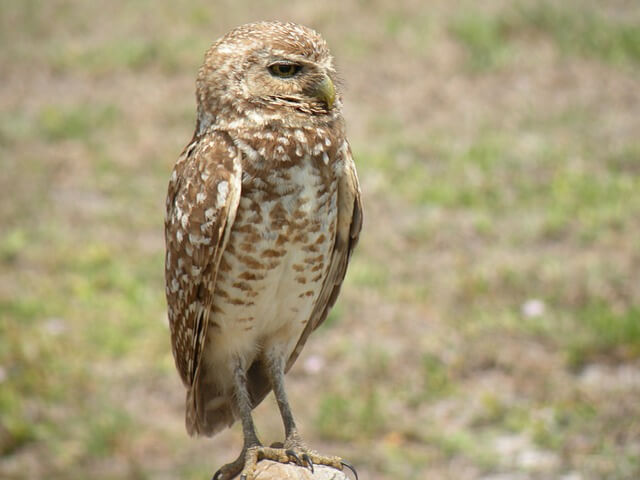
- Length: 7.5-9.8 in (19-25 cm)
- Weight: 5.3 oz (150 g)
- Wingspan: 21.6 in (55 cm)
- Scientific Name: Athene cunicularia
- Frequency of Occurrence: 0.0001%
- Maps: Range Map – Sightings Map
- Sounds: Calls and Songs
- Where To Find Them: Here are some of the best places for spotting Burrowing Owls in Maine:
For starters, you can’t go wrong with Acadia National Park near Bar Harbor. This park’s rugged coastline provides shelter and food for many endangered species, including the Burrowing Owl. In addition, nearby Fort Popham State Historic Site offers stunning views from atop the rocky peninsula. There’s even an observation platform where you can get a bird’s eye view!
- How to Attract: Start by creating a habitat that is suitable for these little birds. Provide open areas of short grasses and shrubs which they can use as perching spots and nesting sites. Leave old logs or brush piles near the edge of your fields, as this gives the owls places to hide during the day when they’re not hunting.
General Information: The Burrowing Owl is a fascinating species of owl that has many unique characteristics and behaviors. These owls are found throughout North and South America from Canada to Argentina, inhabiting open grasslands, agricultural fields and deserts. They live in underground burrows that they often excavate themselves or take over from other animals like skunks or badgers.
Burrowing Owls prefer to hunt at night, eating a variety of small mammals, insects and sometimes even fruits and vegetables. This makes them one of the most varied avian predators out there! They also have large yellow eyes, which help them spot their prey more easily in the dark. All in all, the Burrowing Owl is an incredible species with amazing adaptations for its environment – making it truly special!
Read More: Really Cool Burrowing Owl Facts That Will Amaze You!
Boreal Owl
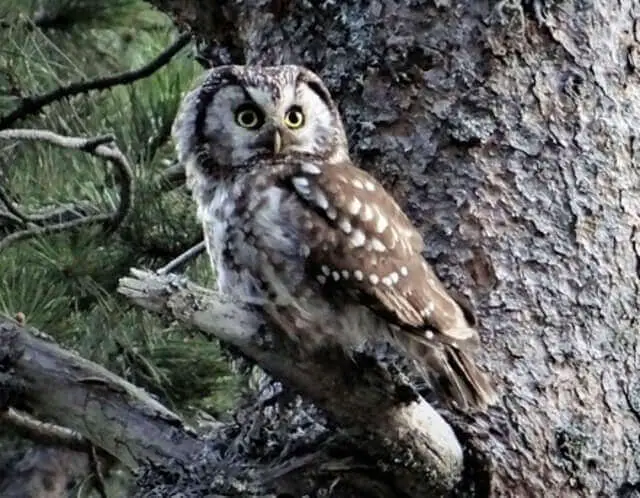
- Length: 8.3-11.0 in (21-28 cm)
- Weight: 3.3-7.6 oz (93-215 g)
- Wingspan: 21.6-24.4 in (55-62 cm)
- Scientific Name: Aegolius funereus
- Frequency of Occurrence: 0.0001%
- Maps: Range Map – Sightings Map
- Sounds: Calls and Songs
- Where To Find Them: For the best chance to see Boreal Owls in Maine, head to the northernmost reaches of the state. Here, large tracts of evergreen forests make ideal homes for these owls and offer plenty of places to spot them. Keep an eye out along trails near Grand Lake Matagamon or Aroostook State Park; they often take perches atop trees there. It’s also worth exploring some lesser-known spots, such as Moro Plantation or Allagash Wilderness Waterway, where you can hear the haunting calls that reveal their presence in an area.
- How to Attract: Start by creating a habitat that will entice them. Boreal owls need plenty of trees that are large enough for nesting and roosting sites as well as dense undergrowth for cover. They also require open areas like meadows or fields for hunting grounds. To increase their chances of coming, provide food sources such as mice, voles, beetles, moths and other insects they enjoy eating. You can even put out bird feeders filled with suet or nuts in order to attract these birds directly to your yard!
General Information: The mysterious and elusive Boreal Owl is a captivating creature found across the Northern Hemisphere. These owls, with their steely-gray feathers and yellow eyes, are a sight to behold in their natural habitats. From boreal forests to tundra regions, these owls call many different places home. The range of the Boreal Owl is vast, covering much of North America and Europe.
In particular, they can be found in Alaska, Canada’s coniferous forest belt, Scandinavia and Siberia. They typically remain near bodies of water where they can find plenty of food sources such as voles, mice and other small mammals. The thick layers of trees provide them ideal cover against predators — an important factor for any bird species looking to survive in the wild!
Barn Owl
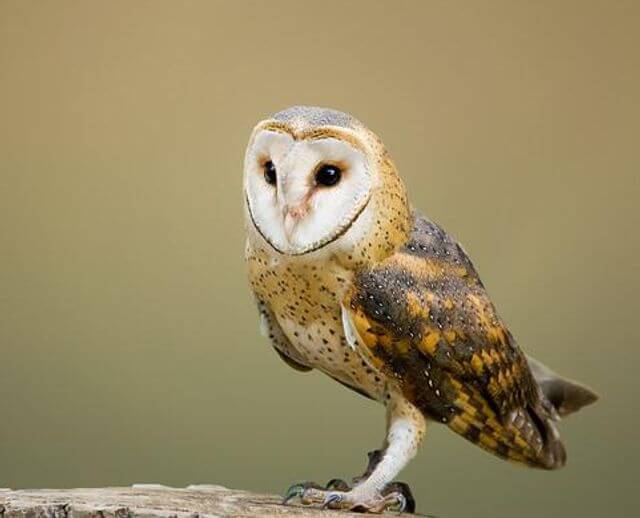
- Length: 12.6-15.8 in (32-40 cm)
- Weight: 14.1-24.7 oz (400-700 g)
- Wingspan: 39.4-49.2 in (100-125 cm)
- Scientific Name: Tyto alba
- Frequency of Occurrence: 0.0001%
- Maps: Range Map – Sightings Map
- Sounds: Calls and Songs
- Where To Find Them: The best place to see Barn Owls in Maine is at Acadia National Park. Located on Mount Desert Island, this park offers plenty of open space and tall trees perfect for nesting and hunting. You can spot them flying over cliffs, meadows, and forests looking for small rodents as they hunt for food. The best time to visit Acadia National Park is during dawn or dusk, when Barn Owls are more active and visible. For those up early enough, sunrise hikes are always a good option!
- How to Attract: Start by providing a suitable habitat. Barn owls need ample cover and places to nest, so consider planting trees with dense foliage or tall grasses that provide both food sources and shelter from predators. You should also provide open areas for hunting and plenty of perches for roosting. Adding a nesting box is another great way to encourage barn owls in your yard, as these birds often rely on tree cavities or rock crevices for their homes.
General Information: The Barn Owl is an amazing bird of prey that has a wide range, inhabiting many habitats across the world. These birds can be found in North and South America, Africa, Eurasia and Oceania. They prefer open grasslands with scattered trees or shrubs for roosting and nesting sites.
Barn Owls mainly feed on small mammals but occasionally consume large insects, other birds, reptiles and amphibians. Their diet varies from region to region based on availability of prey species. In areas where these birds are abundant, they can be extremely beneficial as they help reduce rodent populations naturally.
Related Post:

